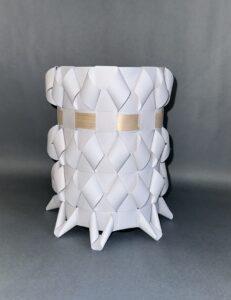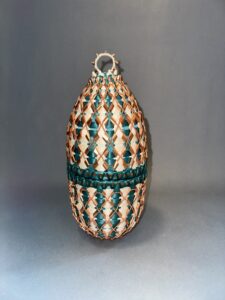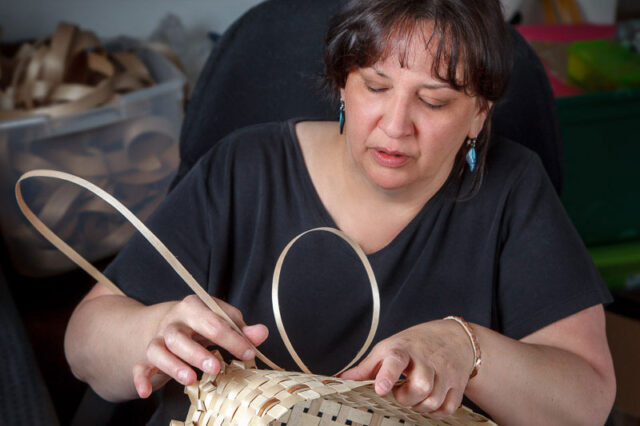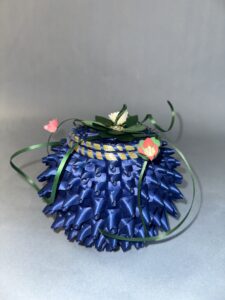A sense of urgency
New and existing works by fifth- and sixth-generation Indigenous basket weavers are displayed at the University of Michigan Stamps Gallery, part of the Stamps School of Art & Design, through Dec. 15.
“In Our Words: An Intergenerational Dialogue” features the works of contemporary artists Kelly Church (Potawatomi/Odawa/Ojibwe) and Cherish Parrish (Potawatomi/Odawa). Their traditional basket weaving material — from black ash trees — is being attacked by an invasive species of beetle, the emerald ash borer, which kills the trees by eating the tissue under the bark.
“You couldn’t commercialize black ash basket weaving because the trees have to grow for 25 to 40 years, and only maybe five to 10 trees out of 100 are good for baskets,” Church says. “And then you have to pound them with the backside of an axe to split the growth rings. It is hard work.”
Featured in the exhibition is a black and white photograph from 1919 of Church’s family, an unbroken family line of basket weavers. Her grandmother once said to her, “We have been making baskets since before they were making cameras.”
The weight and the honor of this tradition is not something Church or her daughter, Parrish, take lightly. And in the face of the looming extinction of black ash trees, the responsibility of keeping this practice alive for future generations has a new sense of urgency.
Her striking “fibergé eggs” and colorful baskets all tell a story.
“Our Native people have always passed things on orally. They’re not written down … we feel that if we begin to write things down and record, you’ll get comfortable that it is always there, and then you won’t practice it anymore,” Church says. “Who is going to do this when there are so many easier things to do today to make money? It takes a certain kind of person. It’s a labor of love, and being able to pass it on and share it with the next generation is one of my main goals.”
Preserving knowledge

This Seventh Generation black ash basket by Kelly Church is part of the current exhibit. (Image courtesy of the artist.)
With black ash basket weaving in particular, it would be close to impossible to teach this art form at a mass scale. Church says harvesting and processing a black ash tree is 75% of the work of creating a basket.
“We have 803 million black ash trees on public lands in Michigan, and we’ve lost probably over 650 to 700 million,” she says. “With the emerald ash borer killing all the ash trees, we have to look at all ways of preserving the knowledge.”
Exhibits like this one are one way of preserving that knowledge.
Church works in service of the Seventh Generation principle — an Indigenous philosophy that encourages people to consider their decisions around energy, water, and natural resources, and the long-term impact those decisions will have on the next seven generations.
“We are supposed to look seven generations ahead … not just for my grandkid, but for people I will never meet,” she says. “So the ‘Seventh Generation basket’ is about this future where black ash is scarce, and we are weaving with what we have, maybe vinyl. It’s a cautionary piece. The basket with no ash at all reminds us — this is what could happen if we don’t preserve.”
Something that changes, but never ends

Continuum, by Kelly Church, has no ash in it — it is made of vinyl. The artist used emerald green dye, which is the color of the emerald ash borer, and copper embellishment because the metallic green bug has a copper belly. The piece is featured in the current exhibit. (Image courtesy of the artist.)
Her Seventh Generation baskets are meant to draw people in in a way that, in her experience, just discussing black ash tree extinction and this specific type of bug cannot do.
“This piece I call Continuum has no ash in it — it is made of vinyl,” she says. “I used emerald green dye, which is the color of the emerald ash borer, and copper embellishment because this metallic green bug has a copper belly.
“I wanted to reflect that beauty,” she continues. “Inside Continuum, I’ve woven copper beads to show that the line continues, that it’s all connected — continuum is something that changes but never ends. The Seventh Generation, the future, might have to carry on with vinyl, with other materials and no ash, but it will continue nonetheless.”
Church regularly revisits past stands of black ash to see how they are sustaining. She is careful of over harvesting and giving forests a chance to “rest,” cycling through the areas in which they live. Upon revisiting, she generally finds that 99% of the trees are dead, but 1% are still alive. Forestry agencies and other institutions have come to study these surviving trees and understand their genetic properties to potentially use them in reseeding efforts.
While the future of the black ash tree population may be uncertain, the work Church is doing today will ensure the future of this important Indigenous tradition is not.
“In Our Words” is open through Dec. 15, 2024, and is curated by Srimoyee Mitra, Stamps gallery director, with curatorial assistant Zoi Crampton. The University of Michigan Arts Initiative contributed funding to support the project.





John Low - 2005. PhD, 1981 JD
I am a citizen of the Pokagon Potawatomi. I have curated an exhibit “Black Ash Baskets: Our Storytellers.” It has been on exhibit at the Field Museum of Natural History, Ohio State University, Logan Museum at Beloit College, Schingoethe Center at Aurora University and then headed to the Illinois State Museum. I am a big proponent of using Native curators when exhibiting our material culture.
Reply